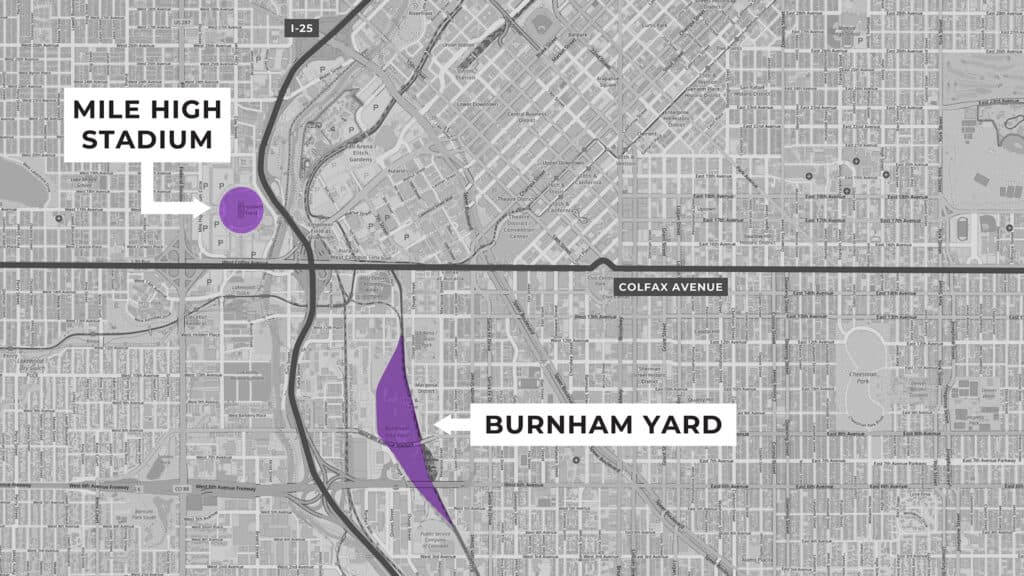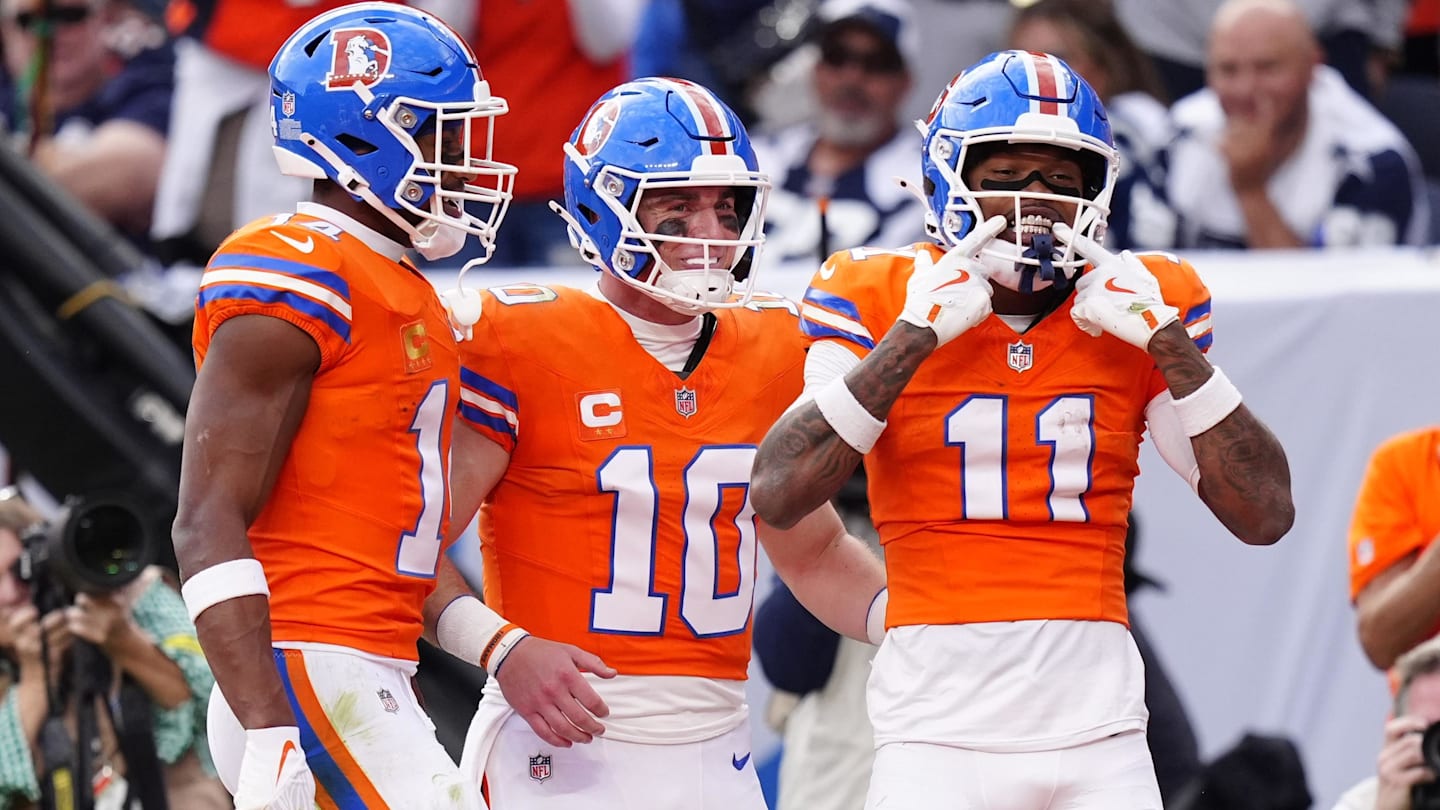Updated at 12:02 p.m. on Tuesday, Sept 9, 2025
The stadium sweepstakes may be over.
The Denver Broncos announced plans to build a new stadium in Denver, moving just about a mile from their longtime home at Empower Field at Mile High, the team’s owners announced Tuesday morning.
The team’s “preferred site” for the new stadium is Burnham Yard, the state-owned former railyard in West Denver. The Broncos had considered moving out of the city, potentially to sites in suburban Lone Tree or Aurora.
The new stadium could open for the 2031 season, the Broncos said.
“Together, we are pleased to announce historic Burnham Yard in the heart of Denver as the preferred site for a world-class retractable roof stadium anchoring a dynamic mixed-use district. Once a vital railyard that played a key role in Denver’s past, Burnham Yard now represents a transformational opportunity to reimagine the future with deep respect for the rich history of the area,” the team said in a statement.
The addition of a retractable roof would mark a significant change from the current stadium. Many Broncos fans take pride in braving the snow and cold at Empower Field, but a roof could make the stadium more attractive to large events beyond football.
“The roof would allow Denver’s games to be played in the elements while maximizing both the year-round flexibility of the stadium and its long-term value to the community,” the team announced.
The team plans to once again use natural turf.
The Broncos say they have “conceptual agreements” to buy the railyard and 25 acres of Denver Water’s campus near the property.
A spokesperson for the Colorado Department of Transportation, which owns Burnham Yard, said he didn’t have any information on the deal. But Gov. Jared Polis said he had been in talks with team owners Greg and Carrie Penner since 2022, with a focus on Burnham Yard.
Meanwhile, the site of the current Broncos stadium would return to the city government’s control in 2030 if the team moves. That’s when the team’s lease expires, though it has the option to extend it as needed.
Mayor Mike Johnston has said that the city won’t spend any public dollars on the stadium itself. And the team’s owners similarly said that “in the spirit of a true civic partnership,” they would privately fund the stadium.

Kevin J. Beaty/Denverite
But the city could fund infrastructure improvements around the stadium, including reconstruction and reconfiguration of nearby road bridges.
“Today is a remarkable win-win-win for Denver,” Johnston said in a press release. “The Broncos are staying in Denver, we will finally open up the historic Burnham Yard for development, and we get to reimagine the Mile High Stadium site as a thriving community in West Denver. The Walton-Penner Ownership Group’s private investment into building a world-class stadium in the heart of Denver will open up new possibilities – not just for Burnham Yard – but across the city.”
That approach would be similar to how the city has handled the planned National Women’s Soccer League stadium in South Denver, where the city is expected to put some $70 million toward roads, bridges, parks and more for the neighborhood.
But there’s one major difference: While the city will own the land beneath the NWSL site, the Broncos are expected to buy and retain ownership of Burnham Yard.
The Broncos noted that Tuesday’s announcement was “a meaningful checkpoint,” but added there “is a long way to go and a lot of work to do.”
The 101 on Burnham Yard (and the Denver Water campus)
Burnham Yard was previously owned by the Union Pacific Railroad, which sold it to the state for $50 million in 2021. The site is 58 acres, shaped like a banana and dotted with aging historic railroad buildings. It’s close to Interstate 25 and the 10th / Osage light rail station.
Companies tied to the team have been buying buildings in the area, BusinessDen reported.
The team is also interested in the neighboring property belonging to Denver Water.
“Making room for a new Broncos stadium while keeping Denver Water whole has been the subject of intense discussion and negotiation between the Broncos and Denver Water for many months,” Denver Water said in a statement.
The utility finished construction on a new headquarters near Burnham Yard in 2019. The headquarters, known as its Administration Building, will stay on the site. But the utility will need to sell land and move buildings on the southern end of its campus.
“Buildings that currently house Denver Water’s operations and maintenance, distribution, trades, fleet, meter shop, warehouse and health clinic workers will need to be relocated,” Denver Water stated.
The Broncos have agreed to pay “all costs necessary to fund Denver Water’s relocation, including, but not limited to, new property acquisitions, site preparation and construction. Funds from water rates will not be used,” according to Denver Water.
The cost of moving Denver Water’s facilities isn’t yet clear. They’ve already made moves on sites at 40th Avenue and Clayton Street in North Denver, as well as at two smaller properties near the current and planned stadium sites.
How much could the team and the city spend?
The city has been negotiating for months to land the stadium, and the mayor’s administration has pushed for significant new spending in the area. Two of the most expensive projects in Johnston’s Vibrant Denver bond package are being prioritized, in part, because of the Broncos’ interest in the area.
The infrastructure spending proposal includes nearly $90 million to remove part of the 8th Avenue viaduct, turning it into a surface street through the old railyard. The proposal also includes another $50 million for repairs, reconfiguration and a design for a future replacement of the 6th Avenue bridge, which also crosses the railyard. City officials note that both bridges are in bad shape and would need work anyway. Voters will weigh in on the overall spending plan in the November election.
- Questions and comments about the Denver Broncos’ stadium plans? Email us.
Meanwhile, the team could put more than $4 billion into the stadium itself, The Denver Post reported. For comparison, SoFi Stadium, near Los Angeles, cost $5.5 billion to build. It serves as the home of the Rams and the Chargers, has a dome ceiling and normally has around 70,000 seats, though it’s able to accommodate more than 100,000 for special events.
Mercedes-Benz Stadium in Atlanta opened in 2017 at a cost of $1.5 billion.
The Broncos owners argue they need a new stadium because its current facility is nearly 30 years old, a point stadiums often “undergo a complete replacement or extensive renovation.” The team also cited “the evolution of fan expectations” and a desire to create year-round business with a mixed-use district built around the new stadium.
That mixed use district could include restaurants, stores, hotels, housing, offices, entertainment venues and “dynamic public spaces,” per the team.
The Broncos’ current stadium, Empower Field at Mile High, opened in 2001. It replaced Mile High Stadium, which was built in 1948. Empower Field cost about $401 million to build, and 75 percent of the construction was funded by sales tax collected from 2001 to 2011 from a six-county area.
The team also could have tried to redevelop the Empower Field site. The city adopted a master plan for the current stadium area in 2019, but the team’s new owners did not pursue that vision of a mixed-use neighborhood. The current stadium needed about $700 million in investment to “remain viable for the next 25 to 30 years,” The Denver Post reported last year.
Instead, the city itself could try to bring new life to the Empower Field site in the future.
Here’s how community members are responding.
Burnham Yard is one of the last big, undeveloped pieces of land in the city. Residents of the La Alma Lincoln Park neighborhood have hoped for decades to see it used for housing, retail, park space, educational and training facilities, said longtime neighborhood organizer Stella Yu.
The city drafted a neighborhood plan in 2010 outlining those potential uses. The city is expected to begin a new local planning process to support the stadium. The development of the stadium could come with other mixed-use development, too.
“The Broncos are fully committed to a strong and inclusive Community Benefits Agreement process that will begin immediately. Together, we will work hand-in-hand with the Denver City Council, local neighborhoods and community organizations—including Denver Water—to shape this vision with their needs and priorities in mind,” the team said.
Our goal for this ambitious project is to build a community that connects fans, neighbors and future generations across Colorado. In addition to creating a modern new home for the Broncos, this vibrant hub will attract premiere events driving impact for Denver and the entire Rocky Mountain Region.
Yu believes the Broncos should stay in Denver, and she hopes the community gets the best deal possible.
“Just letting it sit there is not the best use of the land,” Yu said.
Because the land is an industrial site and needs significant remediation, she said, whoever develops it will need a lot of money – and the Broncos have it.
Meanwhile, community organizer Andrea Barela wishes the Broncos had chosen to move to Lone Tree. West Denver has a long history of projects being dumped on the community without neighborhood input, and this is one more example of that happening, Barela said.
“I also think it’s just wasteful to be building another stadium when we have a perfectly fine stadium, just because we have new owners,” Barela added. “I feel like the rich and the elite get to do what they want, and our community pays for it.”
The Broncos are owned by the Walton-Penner group, including several members of the Walmart empire; former U.S. Secretary of State Condoleezza Rice; investor and local NWSL co-owner Mellody Hobson; and British racing legend Lewis Hamilton.
The Broncos debuted in 1960 in Denver as one of the original American Football League teams, later joining the NFL in the 1970 merger. The team has won three Super Bowls, most recently in 2015. They are 1-0 this season.
Source link

